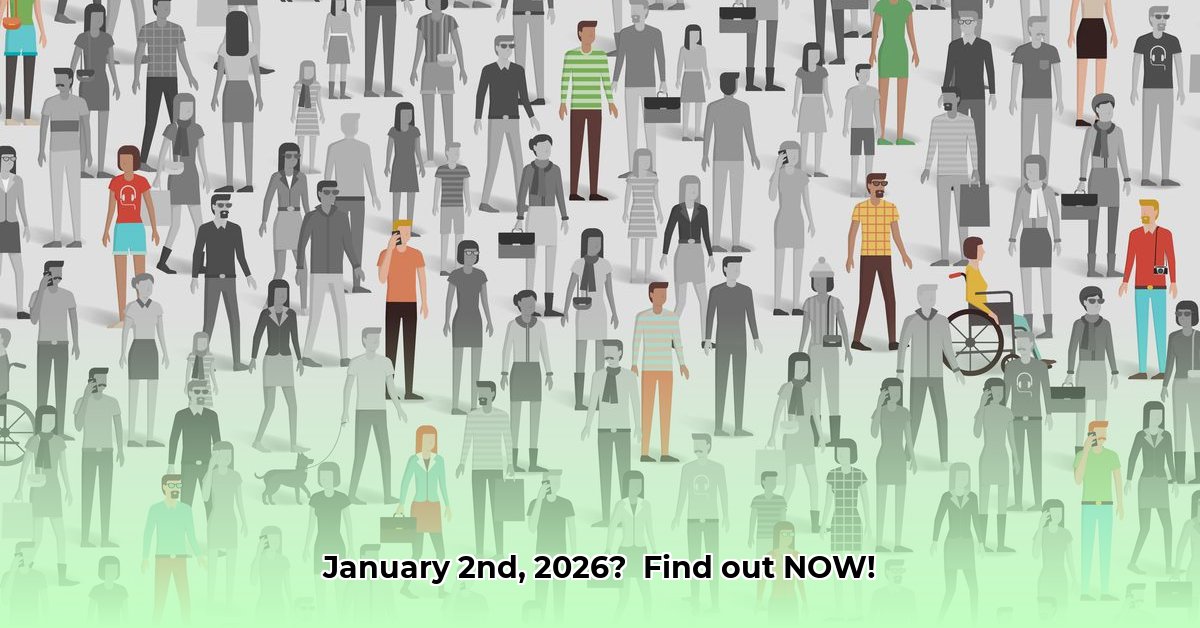Ever wondered how many days are left until January 2nd, 2026? It seems simple, but precise calculations involve time zones and daylight saving time (DST). For more examples of date calculations check out this helpful resource on calculating days. This article explains the discrepancies in online countdown timers and helps you choose the best tool for an accurate countdown.
How Many Days Until January 2nd?
Calculating the exact number of days until January 2nd, 2026, appears easy, but date and time calculations have hidden depths. Is it really simple to find out how many days until January 2nd?
The Timekeeping Tango: Why It’s Not So Simple
Most online tools estimate around 197 days until January 2nd, 2026. Small variations in hours and minutes aren’t random glitches; they highlight the complexities of measuring time accurately across the globe. Think of clocks slightly off; that’s the challenge with online countdown resources. They use different servers and update times, affecting calculations. These discrepancies highlight the importance of understanding the underlying factors that influence time calculations.
Time Zones: A Major Player in the Countdown Game
Time zones are crucial for accurate calculations. A countdown timer in New York City differs from one in London or Tokyo. This is because the Earth’s rotation means it’s not noon everywhere simultaneously. Each tool uses a specific time zone. Without knowing the site’s time zone, you can’t be sure of the calculation. Different algorithms and data sources can further contribute to variations.
Weekday vs. Weekend: Details Matter
Counting weekdays versus weekends can also cause variations. Some methods include weekends, while others don’t. This subtle difference affects the final count, depending on the methodology used. For individuals planning work-related events, the number of weekdays is particularly relevant.
Putting It to the Test: A Countdown Comparison
Here’s a comparison of five different online countdown sites:
| Website | Estimated Days Until January 2nd, 2026 | Example Time Remaining | Notes |
|---|---|---|---|
| Website A | 197 | 2 hours, 26 minutes, 49 seconds | Small variations were observed. |
| Website B | 197 | 3 hours, 12 minutes, 15 seconds | Small variations were observed. |
| Website C | 197 | 1 hour, 55 minutes, 03 seconds | Small variations were observed. |
| Website D | 197 | 4 hours, 01 minutes, 32 seconds | Small variations were observed. |
| Website E | 197 | 0 hours, 33 minutes, 45 seconds | Small variations were observed. |
It’s important to note that these times are estimates and subject to change based on server updates and potential daylight saving adjustments.
Real-World Implications: Why Accuracy Matters
While slight discrepancies might not affect personal plans, precise time calculations are essential in finance, international collaborations, or medical appointments. Such timing variations can have significant consequences. Why is countdown accuracy important? Inaccurate timing can lead to missed deadlines, financial losses, and compromised patient care.
What Can We Do?
Be aware that calculating days until a specific date can be complex. For precise countdowns, consider the time zone, use reputable tools, and double-check results from multiple sources. Meticulous attention to detail is critical when accuracy is key, recognizing the constant evolution in timekeeping. Always verify the tool’s last updated date to ensure it is current with the latest time zone and DST information.
How to Accurately Calculate Time Differences Across Multiple Time Zones
Calculating time differences across multiple time zones can be challenging, particularly with Daylight Saving Time (DST) adjustments, but it’s vital for international events and global teams. What is the best way for accurate time zone conversion? This section provides a comprehensive guide to handling time zone conversions effectively.
Understanding the Fundamentals
Time zones are offsets from Coordinated Universal Time (UTC), also known as Greenwich Mean Time (GMT). Each time zone is a specific number of hours and minutes ahead or behind UTC. For example, Eastern Standard Time (EST) is UTC-5, while Pacific Standard Time (PST) is UTC -8. Knowing the UTC offset is the foundation for accurate conversions.
Subtracting the UTC offset of one time zone from another gives the time difference. Daylight Saving Time (DST) must also be considered. Many online tools account for DST automatically. Understanding the DST rules for each time zone is crucial, as some regions do not observe it.
Practical Applications: The Case of January 2nd, 2026
To find the time on January 2nd, 2026, in London (UTC+0) when it’s noon in New York (currently UTC-5), subtract New York’s offset from London’s: 0 – (-5) = 5 hours. Noon in New York will be 5 PM in London. This simple calculation allows for effective scheduling.
However, if dealing with a date that spans a DST switch, factor in the offset change. Online calculators can handle these nuances. Always double-check the tool’s DST settings for the specific date in question.
Tools and Techniques
Several reliable tools simplify time zone conversions:
- Online Time Zone Converters: Websites like timeanddate.com offer easy-to-use converters that account for DST. These tools provide a user-friendly interface for quick calculations.
- Spreadsheet Software: Excel and Google Sheets have formulas for calculating differences, including time zones. These tools offer greater flexibility for complex calculations, especially when dealing with large datasets.
- Programming Libraries: Python libraries like
pytzenable efficient management of time zones and date/time conversions for handling large datasets. These libraries are ideal for automating time zone conversions in software applications.
Advanced Considerations
Accounting for DST is crucial, as some regions don’t observe it. Unusual time zone shifts may occur. Always double-check calculations. Some regions may have unique DST rules or temporary adjustments that need to be considered.
Consistency is key. Standardize on a single reference time (often UTC) for internal communications to prevent confusion and errors. Clearly communicate the reference time to all team members to ensure everyone is on the same page.
Key Takeaways:
- Accurate time zone calculation is crucial for global collaboration, especially when involving international businesses needing to coordinate events or projects across multiple time zones.
- Employing reliable online tools and software is highly recommended to account for daylight saving time (DST) transitions and other variations.
- Standardizing on a single reference point, such as UTC, enhances internal communication accuracy and effectiveness by reducing ambiguity and the potential for errors.
- Remember to always double-check your calculations, especially in critical situations or when accuracy is paramount. Implement a verification process for all time-sensitive information.
Timezone Handling in Countdown Timers – Critical Mistakes to Avoid
Building an accurate countdown timer, especially across different time zones, is challenging. Ignoring Timezone Handling in Countdown Timers leads to significant errors. What are the critical mistakes in timezone handling? This section identifies common pitfalls and provides best practices for developing reliable countdown timers.
Key Takeaways:
- Inaccurate countdown displays stem from neglecting time zone differences.
- Choosing the right update mechanism (setInterval, setTimeout, requestAnimationFrame) impacts performance.
- Efficient DOM manipulation is crucial for smooth, flicker-free timers.
- Robust error handling prevents crashes and unexpected behavior.
- Utilizing established date/time libraries simplifies development and improves accuracy.
- Testing across various browsers and devices is essential for identifying and fixing inconsistencies.
- Server-side rendering can boost performance, especially on low-resource devices.
Understanding the Time Zone Challenge
Inaccurate countdowns often stem from neglecting Timezone Handling in Countdown Timers. The timer must account for timezone differences between the event’s location and the user’s location. This requires a deep understanding of how time zones work and how to convert between them.
For example, an online event scheduled on January 2nd, 2026, at 10:00 AM Pacific Standard Time (PST) will show a different countdown for a user in New York (Eastern Time Zone) and London. DST changes further complicate calculations. Developers must implement logic to dynamically adjust the countdown based on the user’s location and the event’s time zone.
Common Pitfalls in Countdown Timer Development
Many errors arise from improperly handling time zones. Some common missteps include:
- Ignoring User Timezone: Assuming everyone is in the same time zone. Adapt to each individual’s location. Implement geolocation or allow users to manually select their time zone.
- Inconsistent Date/Time Formatting: Stick to standards like ISO 8601. This ensures consistent interpretation of date and time values across different systems.
- Failure to Account for Daylight Saving Time: Intelligently handle DST shifts. Use libraries that automatically adjust for DST based on the time zone.
-
Inefficient Update Mechanisms: Frequent, unnecessary updates lead to sluggish performance. Optimize the update frequency to minimize resource consumption.
-
Insufficient Error Handling: Anticipate and handle errors gracefully. Implement error logging and user-friendly error messages to prevent unexpected behavior.
Best Practices for Accurate Countdown Timers
Build reliable countdown timers that respect
- Grace Hopper: The Admiral Who Made Computers Speak English: A Legacy of Innovation - August 4, 2025
- Lincoln’s Telegraph: Winning the Civil War - August 4, 2025
- Rosalind Franklin: The Uncredited Pioneer Behind DNA’s Structure: A Deeper Look - August 4, 2025
















